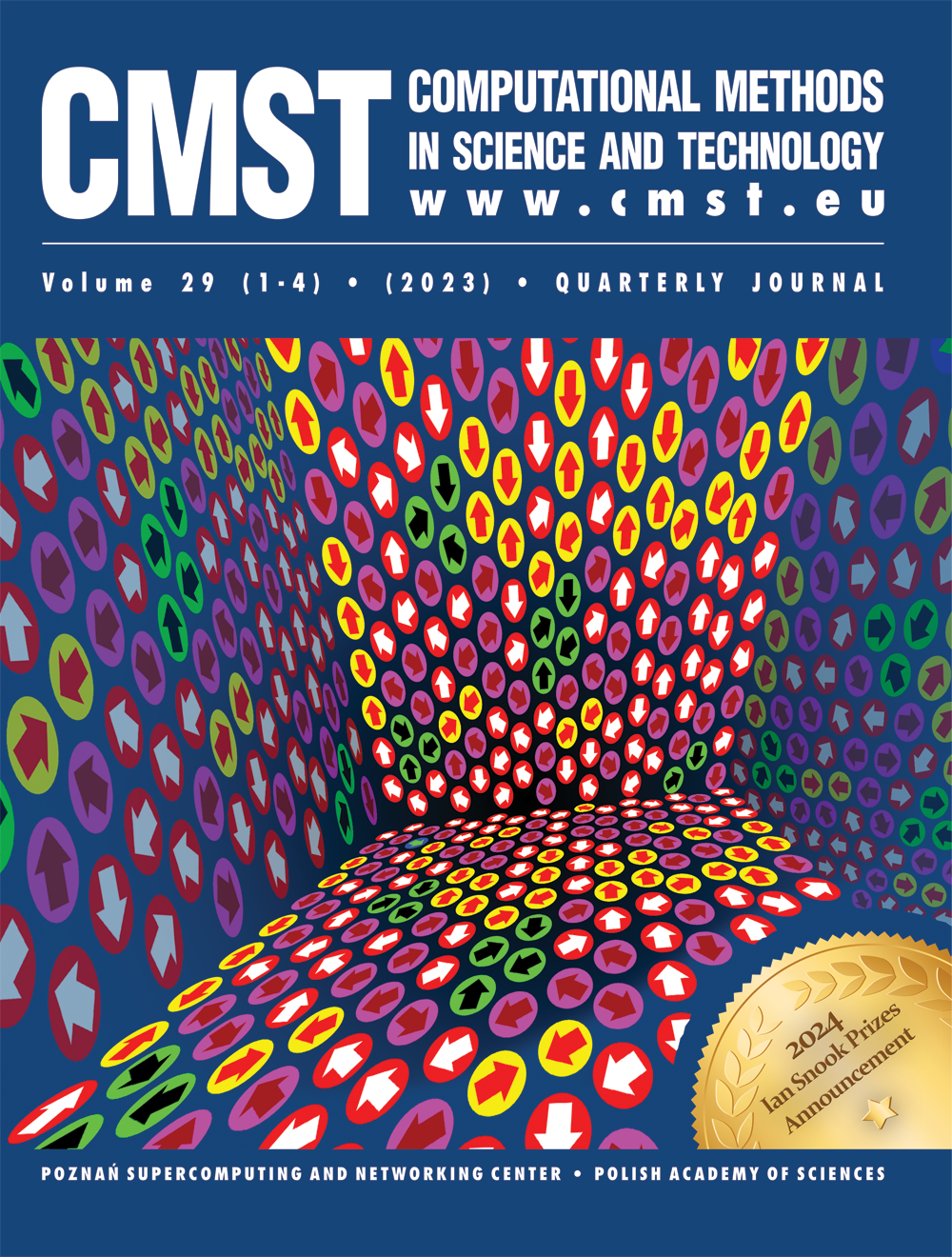TWO INTERACTING PARTICLES IN A PARABOLIC WELL: HARMONIUM AND RELATED SYSTEMS*
Institute of Physics UMK, Grudziądzka 5, 87-100 Toruń, Poland
Received:
Rec. 10 November 2003
DOI: 10.12921/cmst.2003.09.01.67-78
OAI: oai:lib.psnc.pl:552
Abstract:
The quasi-exactly solvable problem of two interacting electrons confined by a parabolic potential (harmonium) has been generalized for the case of two arbitrary particles. Several new features of the analytical solutions are presented.
References:
[1] N. R. Kestner and O. Sinanoğlu, Study of electron correlation in helium-like systems using an exactly soluble model, Phys. Rev. 128, 2687-2693 (1962).
[2] V. Singh, S. N. Biswas and K. Datta, Anhannonic oscillator and the analytic theory of continued fractions, Phys. Rev. D18, 1901-1908 (1978).
[3] M. Znoil, Elementarv bound states for the power-law potentials, J. Phys. A: Math. Gen. 15, 2111-2122 (1982).
[4] M. Taut, Two electrons in an external oscillator potential: Particular analytic solutions of a Coulomb correlation problem, Phys. Rev. A48, 3561-3566 (1993).
[5] M. Taut and A. Ernst, Two electrons in an external oscillator potential: midtiplet splittings from exact solutions and one-particle approximations, J. Phys. B: At. Mol. Opt. Phys. 31, L35-L40 (1998).
[6] M. Taut, A. Ernst, and H. Eschring, Two electrons in an externa! oscillator potential: exact solutions versus one-particle approximations, J. Phys. B: At. Mol. Opt. Phys. 31, 2689-2708 (1998).
[7] J. Cioslowski and K. Pernal, The ground state of harmonium, J. Chem. Phys. 113, 8434-8343 (2000).
[8] L. Cyrnek, The energy spectrum of harmonium, in: Symmetry and Structural Properties of Condensed Matter, edited by T. Lulek. B. Lulek and A. Wal (World Scientific, Singapore. 2003).
[9] J. Kanvowski and L. Cyrnek. Harmonium, Ann. Phys. xx xx-xx (2004).
[10] P. A. Maksym and T. Chakraborty, Quantum dots in a magnetic field: Role of electron-electron interactions, Phys. Rev. Lett. 65, 108-11 1 (1990).
[11] U. Merkt, J. Huser, and M. Wagner, Energy spectra of two electrons in a harmonic quantum dot, Phys. Rev. B 43, 7320-7323 (1991).
[12] W. Jaskólski, Confined many-electron systems, Phys. Rep. 271, 1-66 ( 1996).
[13] D. Bielińska-Wqż, J. Kanvowski, and G. H. F. Diercksen, Spectra of confined two-electron atoms, J. Phys. B: At. Mol. Opt. Phys. 34, 1987-2000 (2001).
[14] G. Lamouche and G. Fishman, Two interacting electrons in a three-dimensional parabolic quantum dot: a simple solution, .1. Phys.: Condens. Matter 10, 7857-7867 (1998).
[15] A. Samanta and S. K. Ghosh. Correlation in exactly solvable two-particle quantum svslem, Phvs. Rev. A 42, 1178-1183 (1990).
[16] S. K. Ghosh and A. Samanta, Studv of correlation effects in an exactly solvable model two-electron system, J. Chem. Phys. 94, 517-522 (1991).
[17] M. Taut, Special analytical solutions of the Schrödinger equation for two and three electrons in a magnetic field and ad hoc generalizations to N particles, J. Phys.: Condens. Matter 12, 3689-3710 (2000).
[18] M. Taut, K. Pernal, J. Cioslowski, and V. Staemmler, Three electrons in a harmonic oscillator
potential: Pairs versus single particles. J. Chem. Phys. 118, 4861-4871 (2003).
[19] S. K. Bose and N. Gupta. Exact solution nf nonrelativistic Schrödinger equation for certain central physical potentials, Nuovo Cimento B113, 299-328 (1998).
The quasi-exactly solvable problem of two interacting electrons confined by a parabolic potential (harmonium) has been generalized for the case of two arbitrary particles. Several new features of the analytical solutions are presented.
[1] N. R. Kestner and O. Sinanoğlu, Study of electron correlation in helium-like systems using an exactly soluble model, Phys. Rev. 128, 2687-2693 (1962).
[2] V. Singh, S. N. Biswas and K. Datta, Anhannonic oscillator and the analytic theory of continued fractions, Phys. Rev. D18, 1901-1908 (1978).
[3] M. Znoil, Elementarv bound states for the power-law potentials, J. Phys. A: Math. Gen. 15, 2111-2122 (1982).
[4] M. Taut, Two electrons in an external oscillator potential: Particular analytic solutions of a Coulomb correlation problem, Phys. Rev. A48, 3561-3566 (1993).
[5] M. Taut and A. Ernst, Two electrons in an external oscillator potential: midtiplet splittings from exact solutions and one-particle approximations, J. Phys. B: At. Mol. Opt. Phys. 31, L35-L40 (1998).
[6] M. Taut, A. Ernst, and H. Eschring, Two electrons in an externa! oscillator potential: exact solutions versus one-particle approximations, J. Phys. B: At. Mol. Opt. Phys. 31, 2689-2708 (1998).
[7] J. Cioslowski and K. Pernal, The ground state of harmonium, J. Chem. Phys. 113, 8434-8343 (2000).
[8] L. Cyrnek, The energy spectrum of harmonium, in: Symmetry and Structural Properties of Condensed Matter, edited by T. Lulek. B. Lulek and A. Wal (World Scientific, Singapore. 2003).
[9] J. Kanvowski and L. Cyrnek. Harmonium, Ann. Phys. xx xx-xx (2004).
[10] P. A. Maksym and T. Chakraborty, Quantum dots in a magnetic field: Role of electron-electron interactions, Phys. Rev. Lett. 65, 108-11 1 (1990).
[11] U. Merkt, J. Huser, and M. Wagner, Energy spectra of two electrons in a harmonic quantum dot, Phys. Rev. B 43, 7320-7323 (1991).
[12] W. Jaskólski, Confined many-electron systems, Phys. Rep. 271, 1-66 ( 1996).
[13] D. Bielińska-Wqż, J. Kanvowski, and G. H. F. Diercksen, Spectra of confined two-electron atoms, J. Phys. B: At. Mol. Opt. Phys. 34, 1987-2000 (2001).
[14] G. Lamouche and G. Fishman, Two interacting electrons in a three-dimensional parabolic quantum dot: a simple solution, .1. Phys.: Condens. Matter 10, 7857-7867 (1998).
[15] A. Samanta and S. K. Ghosh. Correlation in exactly solvable two-particle quantum svslem, Phvs. Rev. A 42, 1178-1183 (1990).
[16] S. K. Ghosh and A. Samanta, Studv of correlation effects in an exactly solvable model two-electron system, J. Chem. Phys. 94, 517-522 (1991).
[17] M. Taut, Special analytical solutions of the Schrödinger equation for two and three electrons in a magnetic field and ad hoc generalizations to N particles, J. Phys.: Condens. Matter 12, 3689-3710 (2000).
[18] M. Taut, K. Pernal, J. Cioslowski, and V. Staemmler, Three electrons in a harmonic oscillator
potential: Pairs versus single particles. J. Chem. Phys. 118, 4861-4871 (2003).
[19] S. K. Bose and N. Gupta. Exact solution nf nonrelativistic Schrödinger equation for certain central physical potentials, Nuovo Cimento B113, 299-328 (1998).



